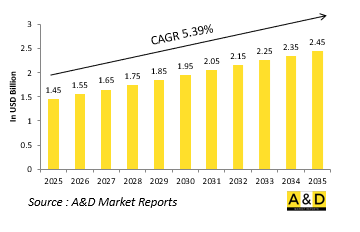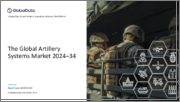
|
시장보고서
상품코드
1733890
세계의 105mm 시장(2025-2035년)Global 105mm Market 2025-2035 |
||||||
전 세계 105mm 시장 규모는 2025년에 14억 5,000만 달러로 추정되며, 2035년에는 24억 5,000만 달러에 달할 것으로 예상되며, 예측 기간인 2025-2035년 동안 5.39%의 CAGR로 성장할 것으로 예상됩니다.

105mm 시장 소개
105mm 구경은 포병전 및 장갑전 상황에서 중요한 자산으로 자리매김하고 있으며, 견인 곡사포와 자주포, 경전차 및 돌격포에 사용되는 것으로 알려져 있습니다. 화력과 기동성의 균형이 잘 잡혀 있어 원정 부대와 신속 전개 부대에 적합합니다. 이 구경은 상대적으로 작기 때문에 특히 복잡한 지형이나 접근이 제한된 환경과 같이 무거운 주포가 논리적으로 실용적이지 않은 시나리오에서도 사용할 수 있습니다. 105mm는 고화력탄, 연막탄, 조명탄, 정밀유도탄을 발사할 수 있어 보병 지원, 요새진지 무력화, 적의 작전 교란 등 다용도로 사용할 수 있습니다. 다양한 플랫폼과 호환이 가능하기 때문에 특히 공격력을 희생하지 않고 기동성을 우선시하는 부대에 있어 세계 방어 전략에서 중요한 요소로 자리매김하고 있습니다.
105mm 시장에서 기술의 영향
기술의 발전은 105mm 구경의 능력을 크게 향상시켜 현대 전투에서 105mm 구경의 지속적인 유효성을 보장합니다. 추진제의 화학적 개선과 포신 설계의 개선으로 사거리와 정확도가 향상되어 원거리 표적을 보다 정확하게 공격할 수 있게 되었습니다. 디지털 화기 통제 시스템의 도입으로 포수는 탄도 계산을 신속하게 할 수 있게 되어 응답 시간이 단축되고 외부 조준에 대한 의존도가 낮아졌습니다. 또한, 정밀유도탄과 센서융합탄 등 첨단 탄약의 개발로 105mm의 전술적 유용성이 확대되어 이동하는 표적을 효과적으로 공격하고 부수적 피해를 최소화할 수 있게 되었습니다. 네트워크화된 전장 시스템과의 통합을 통해 조정과 효율성이 더욱 강화되어 105mm 플랫폼이 합동작전에서 원활하게 활동할 수 있게 되었습니다. 모바일 플랫폼은 안정화 기술과 반동 관리 기술을 통해 빠른 속도의 기계화 전투에서 매우 중요한 이점인 이동 중에도 정확한 사격을 가능하게 합니다. 이러한 기술적 강화로 인해 105mm 구경은 전통적 및 현대적 군사 구조 모두에서 강력하고 유연한 화력 지원 자산으로서의 역할을 계속 수행할 수 있습니다.
105mm 시장의 주요 촉진요인
105mm 시스템에 대한 지속적인 수요는 이 구경의 지속적인 가치를 보여주는 다양한 작전적 및 전략적 요인에 의해 형성되고 있습니다. 주요 촉진요인 중 하나는 특히 공수부대와 경보병 부대가 신속하게 배치 및 재배치할 수 있는 기동성 높은 화력 지원을 필요로 한다는 점입니다. 105mm는 무거운 대포의 후방 지원 부담 없이 이러한 부대의 능력을 크게 향상시킬 수 있는 수준의 화력을 제공합니다. 또한, 다양한 탄약을 발사할 수 있는 다재다능함도 매력적이며, 지휘관은 작전 요건에 따라 효과를 조정할 수 있습니다. 비용 효율성도 중요한 역할을 하며, 105mm 시스템과 탄약은 일반적으로 전장에서 의미 있는 영향을 미치면서도 더 큰 구경에 비해 더 경제적인 옵션을 제공합니다. 또한, 많은 국가들이 105mm를 구식 시스템에서 최신 시스템으로 부대를 전환하는 데 있어 전략적 교량 역할을 하는 것으로 간주하고 있으며, 기존 플랫폼을 현대화하는 업그레이드 프로그램에 105mm를 포함시키는 경우가 많습니다. 견인형과 차량 탑재형 모두에 대한 적응성은 전통적인 야전 포병 부대부터 즉각적인 대응 부대 및 특수 부대까지 다양한 부대 구조에 지속적으로 통합될 수 있도록 돕습니다.
세계의 105mm 시장에 대해 조사 분석했으며, 성장 촉진요인, 향후 10년간의 전망, 지역별 동향 등의 정보를 전해드립니다.
목차
105mm 시장 보고서의 정의
105mm 시장 세분화
지역별
유형별
유도별
플랫폼별
향후 10년간 105mm 시장 분석
105mm 시장 기술
세계의 105mm 시장 예측
지역의 105mm 시장 동향과 예측
북미
촉진요인, 억제요인, 과제
PEST
시장 예측과 시나리오 분석
주요 기업
공급업체 Tier 상황
기업 벤치마크
유럽
중동
아시아태평양
남미
액세스 제어 시장 분석 : 국가별
미국
방위 프로그램
최신 뉴스
특허
이 시장의 현재 기술 성숙도
시장 예측과 시나리오 분석
캐나다
이탈리아
프랑스
독일
네덜란드
벨기에
스페인
스웨덴
그리스
호주
남아프리카공화국
인도
중국
러시아
한국
일본
말레이시아
싱가포르
브라질
105mm 시장 기회 매트릭스
105mm 시장 보고서에 관한 전문가의 의견
결론
Aviation and Defense Market Reports 소개
ksm 25.06.11The Global 105mm market is estimated at USD 1.45 billion in 2025, projected to grow to USD 2.45 billion by 2035 at a Compound Annual Growth Rate (CAGR) of 5.39% over the forecast period 2025-2035.

Introduction to 105mm Market:
The 105mm caliber has established itself as a critical asset in the artillery and armored warfare landscape, known for its use in both towed and self-propelled howitzers as well as light tanks and assault guns. It offers a balance between firepower and mobility, making it suitable for expeditionary and rapid deployment forces. The caliber's relatively moderate size allows it to be employed in scenarios where heavier artillery might be logistically impractical, especially in complex terrains or limited-access environments. It has been a staple in many national armies for decades and continues to be a favored choice in modernization efforts due to its reliability and adaptability. The 105mm's capability to deliver high-explosive, smoke, illumination, and precision-guided rounds makes it a versatile tool for supporting infantry, neutralizing fortified positions, and disrupting enemy operations. Its widespread availability and compatibility with a range of platforms reinforce its position as a key element in global defense strategies, particularly for forces that prioritize maneuverability without sacrificing striking power.
Technology Impact in 105mm Market:
Advancements in technology have significantly elevated the capabilities of the 105mm caliber, ensuring its continued relevance in modern combat. Improvements in propellant chemistry and barrel design have enhanced range and accuracy, enabling forces to strike targets at extended distances with greater precision. The introduction of digital fire control systems has allowed gunners to calculate ballistic solutions rapidly, improving response times and reducing dependency on external targeting. Additionally, the development of advanced munitions, including precision-guided and sensor-fused rounds, has expanded the tactical utility of the 105mm, enabling it to effectively engage moving targets and minimize collateral damage. Integration with networked battlefield systems has further enhanced coordination and effectiveness, allowing 105mm platforms to operate seamlessly within joint operations. On mobile platforms, stabilization and recoil management technologies have made it possible to fire accurately on the move, a crucial advantage in fast-paced mechanized warfare. These technological enhancements collectively ensure the 105mm caliber continues to serve as a potent and flexible fire support asset in both legacy and modern military structures.
Key Drivers in 105mm Market:
The ongoing demand for 105mm systems is shaped by a range of operational and strategic factors that highlight the caliber's enduring value. One of the main drivers is the need for highly mobile fire support that can be quickly deployed and repositioned, especially by airborne and light infantry units. The 105mm provides a level of firepower that significantly enhances these units' capabilities without imposing the logistical burden of heavier artillery. Its versatility in firing a broad range of munitions also contributes to its appeal, allowing commanders to tailor effects based on mission requirements. Cost-effectiveness plays a key role, as 105mm systems and ammunition generally present a more economical option compared to larger calibers while still delivering meaningful battlefield impact. Many countries also view the 105mm as a strategic bridge in transitioning forces from older systems to more advanced ones, often incorporating the caliber into upgrade programs that modernize existing platforms. Its adaptability to both towed and vehicle-mounted configurations further supports its continued integration into diverse force structures, from traditional field artillery units to rapid reaction forces and specialized contingents.
Regional Trends in 105mm Market:
The global deployment of 105mm systems reflects diverse regional defense strategies and operational needs. In North America and Europe, the caliber has seen sustained use, particularly in light artillery and reconnaissance platforms, and is often upgraded with modern targeting and fire control systems to extend its service life and enhance combat effectiveness. NATO allies continue to maintain and integrate 105mm platforms as part of combined arms doctrines and multinational training programs. In Asia-Pacific, several countries are investing in 105mm systems for their lighter armored vehicles and artillery units, valuing the caliber for its utility in varied terrain and rapid deployment scenarios. Middle Eastern forces incorporate the 105mm in both conventional warfare and internal security roles, where precision and mobility are critical. Across Africa and Latin America, the 105mm remains popular due to its affordability, ease of maintenance, and suitability for rugged conditions. These regions often utilize surplus Western systems or develop indigenous variants, reflecting local manufacturing capabilities and strategic autonomy goals. These trends illustrate the caliber's adaptability and ongoing strategic importance in shaping regional and global defense capabilities.
Key 105mm Program:
A total of RM12 billion has been earmarked for asset procurement this year, marking a significant allocation when compared to the 2025 defense budget. Among the key assets slated for acquisition are 105mm howitzers for the Army, surface-to-surface missiles for the KD Jebat, and three Medium Altitude Long Endurance Unmanned Aerial Systems (MALE UAS). The MALE UAS mentioned are likely to be the Anka drones from Turkish Aerospace, which were previously contracted. This suggests that delivery of the three drones could take place within the year. Regarding the 105mm howitzers, industry sources indicate that the procurement will support two artillery regiments. Currently, the Army fields one regiment equipped with KNDS LG1 Mark III howitzers (1 RAD, part of the 10th Para Brigade), as well as multiple regiments operating Oto Melara 105mm pack howitzers. A formal tender process for the new howitzer acquisition is anticipated to be launched later this year.
Table of Contents
105mm Market - Table of Contents
105mm market Report Definition
105mm market Segmentation
By Region
By Type
By Guidance
By Platform
105mm market Analysis for next 10 Years
The 10-year 105mm market analysis would give a detailed overview of 105mm market growth, changing dynamics, technology adoption overviews and the overall market attractiveness is covered in this chapter.
Market Technologies of 105mm market
This segment covers the top 10 technologies that is expected to impact this market and the possible implications these technologies would have on the overall market.
Global 105mm market Forecast
The 10-year 105mm market forecast of this market is covered in detailed across the segments which are mentioned above.
Regional 105mm market Trends & Forecast
The regional 105mm market trends, drivers, restraints and Challenges of this market, the Political, Economic, Social and Technology aspects are covered in this segment. The market forecast and scenario analysis across regions are also covered in detailed in this segment. The last part of the regional analysis includes profiling of the key companies, supplier landscape and company benchmarking. The current market size is estimated based on the normal scenario.
North America
Drivers, Restraints and Challenges
PEST
Market Forecast & Scenario Analysis
Key Companies
Supplier Tier Landscape
Company Benchmarking
Europe
Middle East
APAC
South America
Country Analysis of Access Control Market
This chapter deals with the key defense programs in this market, it also covers the latest news and patents which have been filed in this market. Country level 10 year market forecast and scenario analysis are also covered in this chapter.
US
Defense Programs
Latest News
Patents
Current levels of technology maturation in this market
Market Forecast & Scenario Analysis
Canada
Italy
France
Germany
Netherlands
Belgium
Spain
Sweden
Greece
Australia
South Africa
India
China
Russia
South Korea
Japan
Malaysia
Singapore
Brazil
Opportunity Matrix for 105mm market
The opportunity matrix helps the readers understand the high opportunity segments in this market.
Expert Opinions on 105mm market Report
Hear from our experts their opinion of the possible analysis for this market.



















